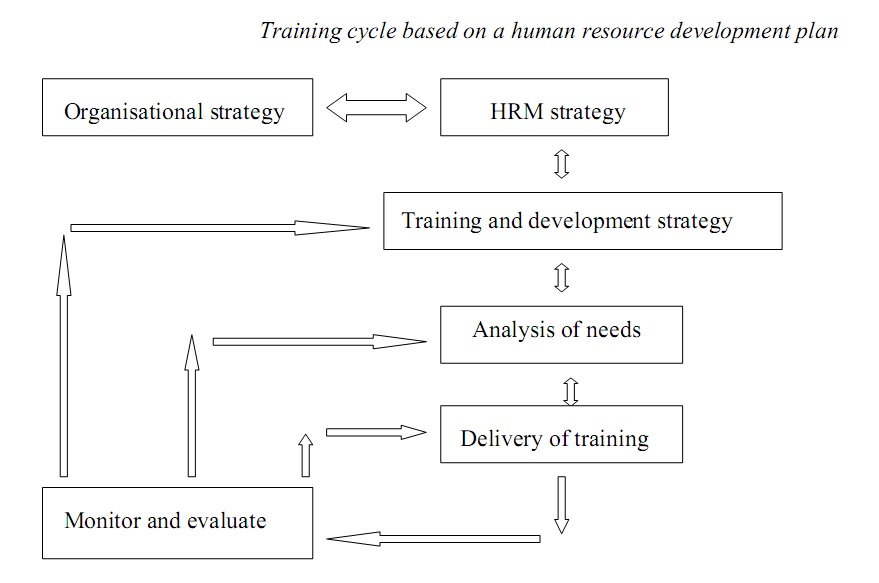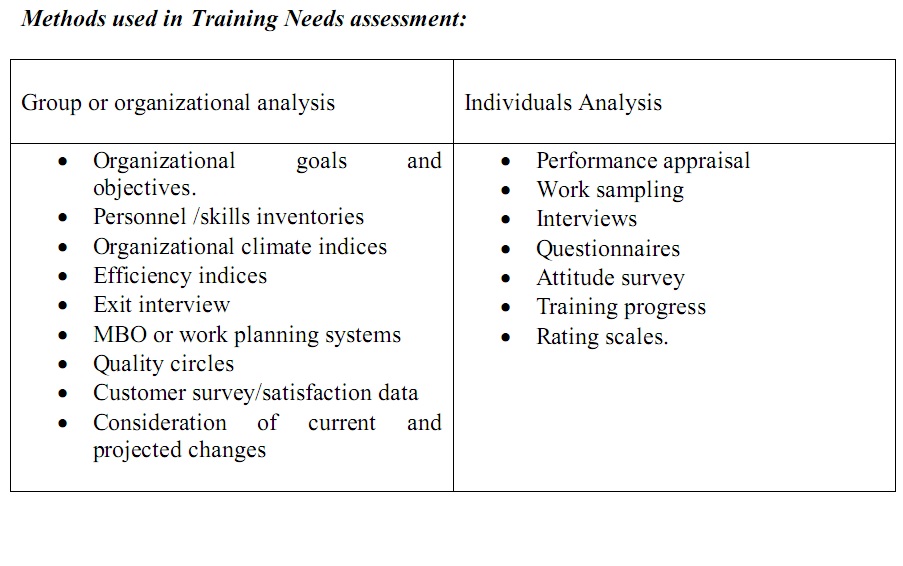Steps in the Training Process
- Organizational objectives
- Assessment of Training needs
. Organisational analysis
. Task Analysis
. Man or HR Analysis
- Establishment of Training goals
- Designing training programmes
- Implementation of training programmes
- Evaluation of results

- Organizational Objectives and Strategies:
The first step in the training process in an organization is the assessment of its objectives and strategies. What business are we in? At what level of quality do we wish to provide this product or service? Where do we want to be in the future? It is only after answering these related questions that the organization must assess the strengths and weaknesses of its human resources.
- Needs Assessment:
Needs assessment diagnosis present problems and future challenges to be met through training and development? Organizations spend vast sums of money (usually as a percentage on turnover) on training and development. Before committing such huge resources, organizations that implement training programs without conducting needs assessment may be making errors.
Needs assessment occurs at two levels- group and individual. An individual obviously needs training when his or her performance falls short of standards, that is, when there is performance deficiency. Inadequacy in performance may be due to lack of skill or knowledge or any other problem. The problem of performance deficiency caused by absence of skills or knowledge can be remedied by training. Faulty selection, poor job design, improving quality of supervision, or discharge will solve the problem.
Assessment of training needs must also focus on anticipated skills of an employee. Technology changes fast and new technology demands new skills. It is necessary that the employee be trained to acquire new skills. This will help him/her to progress in his or her career path. Training and development is essential to prepare the employee to handle more challenging tasks. Individuals may also require new skills because of possible job transfers.
Although job transfers are common as organizational personnel demands vary, they do not necessarily require elaborate training efforts. Employees commonly require only an orientation to new facilities and jobs. Jobs have disappeared as technology, foreign competition, and the forces of supply and demand are changing the face of our industry. Assessment of training needs occurs at the group level too. Any change in the organization’s strategy necessitates training of groups of employees.
Needs Assessment Methods: How are training needs assessed? Several methods are available for the purpose. Fig shows some of them for Organisational level and individual level

Benefits of Needs assessment: As pointed above, needs assessment helps diagnose the causes of performance deficiency in employees. Causes require remedial actions. This being a generalized statement there are certain specific benefits of needs assessment. They are:
- Trainers may be informed about the broader needs of the training group and their sponsoring organizations.
- The sponsoring organizations are able to reduce the perception gap between the participant and his or her boss about their needs and expectations from the training programmes.
- Trainers are able to pitch their course inputs course inputs closer to the specific needs of the participants.
III. Training and Development objectives
Once training needs are assessed, training and development goals must be established. Without clearly set goals, it is not possible to design a training and development programme and, after it has been implemented there will be no way of measuring its effectiveness. Goals must be tangible, verifiable, and measurable.
IV. Designing Training and Development Programme
Trainers should be selected on the basis of self-nomination, recommendations of supervisors or by the HR department itself. Whatever is the basis, it is advisable to have two or more target audience. For example, rank-and-file employees and their supervisors or by the HR department itself.
Several people, including the following may conduct training and Development programmes:
- Immediate supervisors
- Co-workers, as in buddy systems,
- Members of the personnel staff,
- Specialists in other parts of the company,
- Outside consultants,
- Industry associations, and faculty members at universities
V. Methods and Techniques of training
“Training that is planned and structured that takes place mainly at the normal workstation of the trainee- although some instruction may be provided in a special training area on site – and where a manager, supervisor, trainer or peer colleague spends significant time with a trainee to teach a set of skills that have been specified in advance.”
Methods of Evaluation
Various methods can be used to collect data on the outcomes of training. Some of these are:
Questionnaires: Comprehensive questionnaires could be used to obtain opinion reactions, views of trainees.
Tests: Standard tests could be used to find out whether trainees have learnt anything during and after the training.
Interviews: Interviews could be conducted to find the usefulness of training offered to operatives.
Studies: Comprehensive studies could be carried out eliciting the opinions and judgments of trainers, superiors and peer groups about the training.
Human resource factors: Training can also be evaluated on the basis of employee satisfaction, which in turn can be examined on the basis of decrease in employee turnover, absenteeism, accidents, grievances, discharges, dismissals, etc.
Cost benefit analysis: The costs of training (cost of hiring trainers, tools to learn training centre, wastage, production stoppage, opportunity cost of trainers and trainees) could be compared with its value (in terms of reduced learning time improved learning, superior performance) in order to evaluate a training programme.
Feedback: After the evaluation, the situation should be examined to identify the probable causes for gaps in performance. The training evaluation information.(about costs, time spent, outcomes, etc.)should be provided to the instructors’ trainees and other parties concerned for control, correction and improvement of trainees’ activities. The training evaluator should follow it up sincerely so as to ensure effective implementation of the feedback report at every stage.
Please note that no training is complete without its evaluation. That is, the follow up of a training programme is very essential.
Impediments or problems in Training Process:
- Management’s commitment is lacking
- Aggregate spending on training is inadequate
- The trainers may lack skills
- Poaching
- No help in case of downsizing
